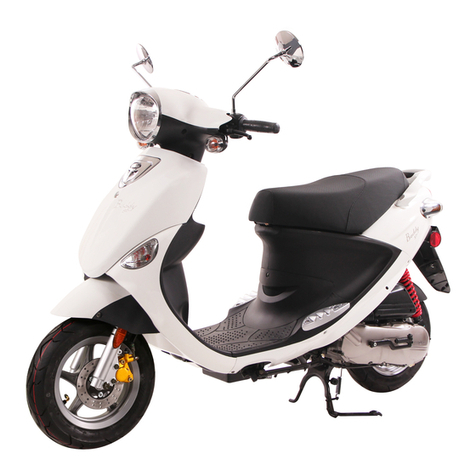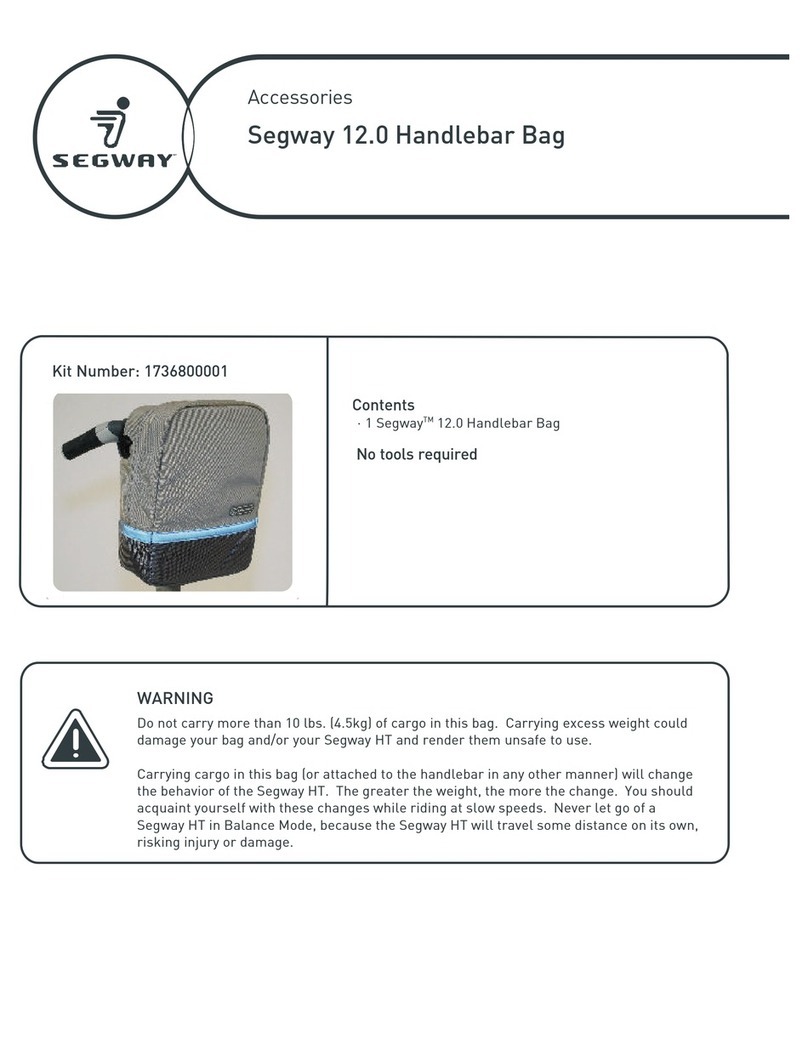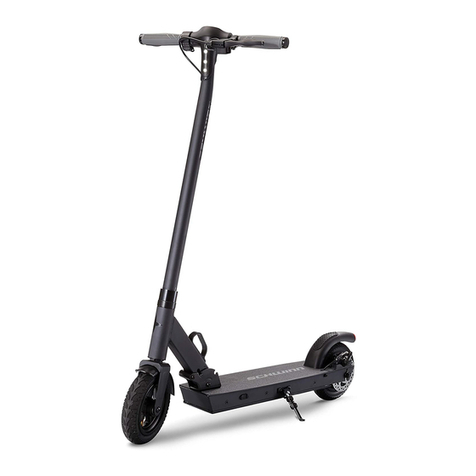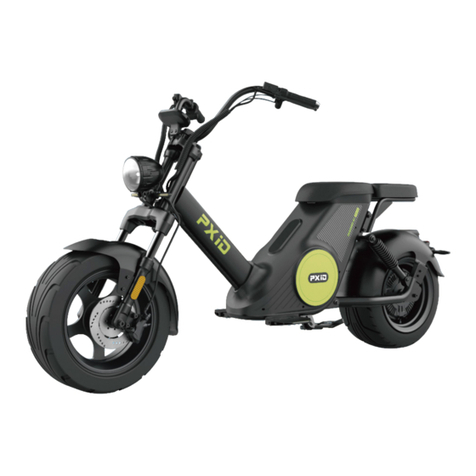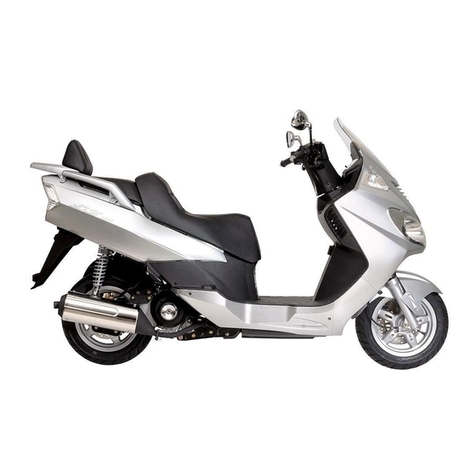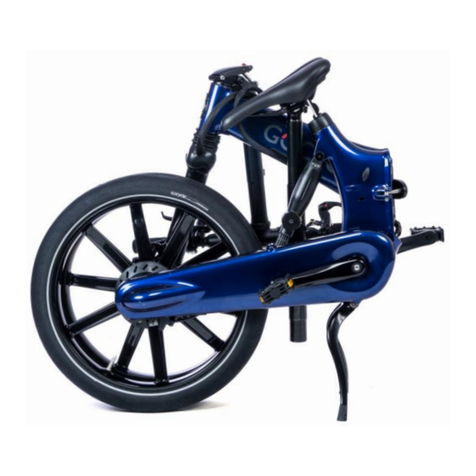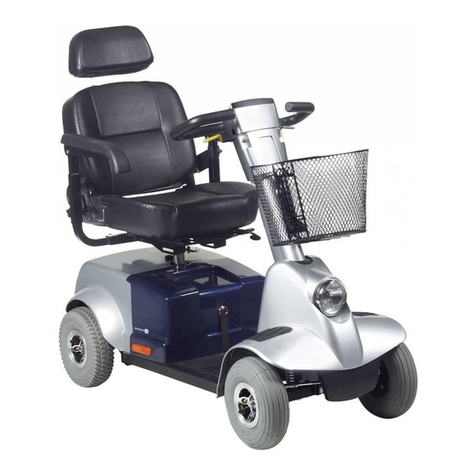GENUINE HOOLIGAN 170i User manual

HOOLIGAN 170I SERVICE MANUAL
This manual offers all service specialists with the technological procedures of
maintenance, repair, and troubleshooting for the Hooligan 170i.
Four-Stroke Cycle, 168CC , 2-valve, electronic injection, Oil-cooled
engine.
1

Contents
This manual is a service manual for Hooligan 170i with details specifying
skills to disassemble or install various mechanisms, basic maintenance (check and
adjustment) of components, notices for operation, and configuration of colored
electrical wires in connection with the motorcycle in which there are 7 chapters and as
references of users or mechanics during service.
Classification Item Page
Information summary and preparation
1
3~21
Installation or Removal of External Components
2
22~45
Check & Adjustment
3
46~64
Fuel Injection System
4
65~81
Engine / Reverse differential gear
5
82~118
shock absorber / brake system/wheel
6
119~129
Cylinder Assembly
7
130~146
wiring
2

Information Summary and Preparation -1
1-1Specifications
SCOOTER SPECIFICATION
BRAND Genuine FRAME STEEL TUBE
MODEL Hooligan 170i
SUSPENSION
FRONT TELESCOPE
SCALE
LENGTH 1870 mm REAR UNI-ABSORBER
WIDTH 710 mm
TRANSMISSIO
1ST REDUCTION 2.65~0.81
HEIGHT 1155 mm 2ND REDUCTION 9.262
WHEEL BASE 1285 mm CLUTCH CENTRIFUGAL
MASS
MASS OF
VEHICLE
FRONT 48 KG GEARBOX C.V.T.
REAR 78 KG
TYRE
FRONT 120/70-12
TOTAL 126 KG REAR 130/70-12
RIDER 2 (150KG)
BRAKE
FRONT DISK
TOTAL MASS
FRONT 89 KG REAR
REAR 187 KG SPEEDOMETER 199 km/hr
TOTAL 276 KG
LIGHT
HEAD LAMP 12V-55W/35W
PERFORMANCE
TOP SPEED 95 km/hr TAIL LAMP 13.5V-0.41W /12V-5W
FUELCONSUMPTION 38 km/l BREAKING LAMP 13.5V-1.89W
HILL CLIMB 26°↑TURNING LIGHT 13.5V-1.58W/13.5V-1.45W
ENGINE
TYPE BF9 HORN DC 12V
FUEL 92 UNLEADED MUFFLER C-D ABSORPTION
C Y C L E / C O O L I NG 4T/FORCE AIR&OIL COOL
IDLE
EMISSION
PARTICLE BELOW 15 %
CYLINDER
BORE φ61.0 mm CO BELOW 3.0%
STROKE 57.8 mm HC BELOW 1600 ppm
NUMBER SINGLE EXHAUST DIRECTION
RIGHT HAND SIDE&
BACKWARD
DISPLACEMENT 168.9 cc LUBRICATION COMPRESS & SPLASH
COMPRESSION RATIO 1 0 . 5:1 E. E. C. NO
MAX POWER 8.2kw/7500rpm P. C. V. YES
MAX TORQUE 10.7N-M/5500rpm CATALYST YES
ARRANGEMENT HORIZONTAL S. A. I. YES
IGNITION TRANSISTOR STARTER ELECTRIC
RREMA
RK 1. FUEL SUPPLY:INJECTION
3

Information Summary and Preparation -1
1-2 Configuration
muffler
HANDLE COVER
SPEEDOMETER
REAR WHEEL
FENDER
SEAT
FRONT BODY COVER
FRONT INNER COVER
FRONT FORK
TUBE COMP
LOWER COVER(L/R)
FRONT LNNER
COVER,LOWER
BRAKE DISC
FRT BRAKE
SIDE REFLECTOR
LEVER(L/R)
GRIP(L/R)
WIND SHIELD
FR SIGNAL LAMP(R/L)
HEAD LIGHT COMP
FRONT WHEEL
BODY COVER,L/R
REAR LUGGAGE
BRACKET
REAR LAMP
AIR CLEANER
REAR SUSPENSION
REAR SIGNAL
HANDLE COVER
CENTER STAND ASSY
SIDE STAND ASSY
4

Information Summary and Preparation -1
1-3 Positions of engine number / vehicle identification number:
1-4 Torque
Rated values
Type Torque (kg-m) Type Torque (kg-m)
5mm bolt 0.4~0.5kg-m 6mm nut 1.0~1.4kg-m
6mm bolt 0.9~1.1kg-m 8mm nut 2.0~3.0kg-m
8mm bolt 1.8~2.5kg-m 10mm nut 3.0~4.0kg-m
10mm bolt 3.0~4.0kg-m Pin / bolt 1.5~2.0kg-m
12mm bolt 5.0~6.0kg-m
Body / Engi
Type Torque
(kg-m) Type Torque
(kg-m) Type Torque
(kg-m)
Disk
Front axle
Handlebar
Engine hanger
Brake caliper
Joint bolt (brake hose)
Brake pump assembly
Rear axle
Front shock absorber
Rear shock absorber
(upper)
(lower)
Exhauster(Front)
Exhauster (Rear)
Rear fork
2.0-2.5
5.0-6.0
4.5-6.0
3.5-4.5
2.0-3.0
3.5±0.2
0.8-1.2
10-11
2.0-2.5
4.7-5.5
2.4-3.0
2.0-3.0
3.1±0.1
2.5-2.8
Sparking plug
Drain plug bolt (engine oil)
Drain plug bolt (gear oil)
Oil strainer cover
Fixed rotor (5mm)
(6mm)
Flywheel
Engine temperature
Left side cover
Cylinder head - nut
Cylinder head - screw
Right Crank case cover
Gear box nut
(Shoe pivot ,rear brake)
Gear box
Cylinder head cover
1.1
2.5-3.0
1.7-2.0
1.5-2.0
0.7-0.9
0.9-1.1
5.0-6.0
1.2±0.2
0.9-1.1
2.2
0.9-1.1
0.9-1.1
2.0-3.0
2.5-2.8
0.9-1.1
Oil pump
Sprkt oil pump driven
Separator,oil
one-way clutch
Stud bolt (cylinder head)
Crank case (left & right)
0.9-1.1
0.9-1.1
0.9-1.1
9.0-10
0.92-1.125
0.9-1.1
Positions of engine number
Vehicle identification number
5

Information Summary and Preparation -1
1-5 Code of practice:
1. Any clamp or cotter pin removed shall be replaced with a new one.
2. Any part to be replaced shall be manufactured by Motive Power.
3. Make sure of any assembled component securely fastened and formally activated.
4. Any bolts or nuts with large external diameters rather than small ones shall be screwed first and
diagonally according to rated torque values as follows.
5. Any mechanic shall use specific or common tools for any disassembly and wear work shoes
during maintenance.
6. The safety of any maintenance operation practiced by two mechanics shall be ensured each
other.
7. Any electrical parts slightly heated with the motorcycle started are normal and not touched by
hands directly.
8. Please keep any cable or wire harness to be installed properly fixed but not excessively
tensioned or loosened without any acute (or sharp) angle or bulged bolt (or screw) piercing a
cable. Check any cable or wire harness installed for any unnecessary twist or kink.
9. Do not put any tool on the motorcycle, particularly the battery unit to become a short circuit,
during maintenance.
10. The battery in a motorcycle which has not been started for a long period shall be tested once to
ensure its voltages and charged per month.
11. Please follow the correct steps to connect and disconnect a lead acid battery without the short
circuit or inflammation.
1-5.1 Directions for maintenance of the Engine Management System (EMS)
1) Directions for General Maintenance
Any check to the Electronic Management System shall be made with a multi-meter only.
1. To make sure of the Electronic Management System properly running, please use parts
supplied by Motive Power during maintenance.
2. Any operation to clean parts during maintenance shall be executed in a well-ventilated place.
3. Please follow the directions for steps of maintenance and diagnosis.
4. Do not disassemble or remove parts in the Electronic Management System during
maintenance.
5. Please keep watch for any electronic element (electronic control unit, sensor, etc.) not fallen to
the ground during maintenance; establish the environmental protection concept for any waste
from maintenance invalidly disposed.
6

Information Summary and Preparation -1
2) Directions during maintenance
1. Do not arbitrarily remove any part or connector of the Electronic Management System from
its initial position; avoid any accidental damage or foreign object such as water and greasy
dirt to enter into any connector and affect a properly running Electronic Management
System.
2. In order to prevent any electrical device from damage, the power supply shall be
disconnected prior to a connector removed or connected.
3. During any operation to simulate the thermal state of one defective unit or increase
temperatures, the temperature of the electronic control unit shall be less than 80 degrees
Celsius.
4. All fuel hoses shall be high pressure-tolerant pipes in virtue of the high fuel pressure in the
Electronic Management System (300kPa or so) or even at the engine stopped. As a result,
the fuel hose during maintenance shall not be disassembled arbitrarily. In the case of
maintaining the fuel system, the pressure in the fuel system shall be released prior to
removal of a fuel hose shown as follows: Remove the fuel pump relay; start the engine; keep
the engine at the idle speed until the engine stops. The operation of removal of a fuel hose
and replacement of a clamp shall be executed by a professional mechanic in a
well-ventilated place.
5. The power supplied to the electric fuel pump which is being removed from the fuel tank
shall be disconnected beforehand to prevent any spark or fire.
6. The fuel pump to be tested shall not be empty or refilled by water or the service life will be
curtailed. On the other hand, the positive and negative poles of the fuel pump shall be
properly connected.
7. Unless otherwise required, the spark test shall not be conducted or be completed quickly
during inspections of the ignition system. Additionally, the air throttle shall be kept closed
during inspections or the incompletely ignited gasoline will be fed into the exhauster and
damage the three-way catalytic converter.
8. The idle speed has been adjusted by the Electronic Management System in advance and not
changed manually. The initial position of the throttle stop screw adjusted by Motive Power
shall not be changed by a user without permission unless otherwise demanded.
9. The cables to be connected to the positive and negative poles on a battery shall be correctly
linked or the electronic devices will be damaged. The minus earth is used in the system.
10. Any cable connected to a battery shall not be disconnected during the engine running.
11. The battery shall be removed from the motorcycle for a charge separately conducted but not
be directly charged with the battery fixed on the vehicle for convenience.
12. The cables connected to the battery’s positive & negative poles and the electronic control
unit shall be removed from the motorcycle prior to any electrical welding operation.
13. Do not cut a cable’s cover layer to test any signal imported to or exported from one device.
7

Information Summary and Preparation -1
1-6 Special tools
1. Front fork - Bearing cage
disassembly, tools
2. Brake oil-pumping unit 3. Bearing puller tool
4. Clutch compression tool 5. Fixator 6. feeler gauge
=
7. Bearing Striking Tools 8.Cylinder pressure gauge 9. Test line group
10. Hook type, wrench 11. RELEASING TOOL,FLYWHEEL
MAGNETO
12. Crankshaft bearing removal tool
13. multimeter 14. Gasoline pressure gauge 15. Valve compression tool
8

Information Summary and Preparation -1
16. spark plug gap gauge 17.EMS diagnostics - dedicated 18. Hose clamp removal tool
19. Fuel injector cleaning tool 20. Oil seal removal tool - small 21. Dial gauge + Magnetic Base
22. Oil seal removal tool - Large 23. Fork oil seal into the tool
9

Information Summary and Preparation -1
1-7 Trouble shooting
Procedure to maintain the Electronic Management System (EMS)
Systematic procedure to diagnose any troubles for reparation
Items to be checked first prior to any diagnoses for engine troubles:
1. Make sure of the engine trouble indicator normally running;
2. Check with a trouble diagnosis meter to ensure no trouble information recorded;
3. Check any trouble phenomenon hinted by the vehicle owner and trouble-related conditions.
External check:
(1) Check any leakage from a fuel hose.
(2) Check any leakage from a vacuum pipe.
(3) Check any jam, leakage, flattening, or damage at an air inlet.
(4) Check the ignition system for break or aging of any high-voltage cable and ignition
status.
(5) Check grounding of any wire harness clean and securely fixed.
(6) Check any sensor or actuator’s connector loosened or poorly contacted.
Note: Repair any trouble specified herein first which may affect the subsequent diagnoses or
reparation.
Diagnosis assist:
1. Make sure of no engine-related trouble records;
2. Make sure of any offered troubles;
3. Follow the said procedure to complete inspections and find no any unconformable situation;
4. Do not ignore any effect from maintenance, cylinder pressure, mechanical timing, or fuel on
the system;
5. Replace ECU for tests.
In the event of any trouble eliminated, ECU should be the source of trouble; if not, install the
original ECU and repeat the procedure to recheck.
Trouble:
Engine not running or slowly running during start-up
Engine running but start-up failing during start-up
Trouble of hot start
Trouble of cold start
Trouble of start-up anytime despite RPM normal
Start-up normal but idle speed unstable anytime
Start-up normal but idle speed unstable during warm-up
Start-up normal but idle speed unstable with warm-up finished
Start-up normal but idle speed unstable or stall with load such as front lamp applied
Start-up normal but idle speed too high
RPM low or stall during acceleration
Acceleration slow
Acceleration powerless; performance bad
10

Information Summary and Preparation -1
(1) Engine not running or slowly running during start-up
General trouble location: 1. Battery; 2. Start motor; 3. Main wiring or power switch; 4. Engine
mechanism.
Procedure for general diagnoses:
No. Operating Procedure Detection
Results Subsequent Steps
1
Check the voltage between two battery terminals with a
multi-meter to ensure the voltage between 11 and 12V
during start-up of the engine.
Yes Nex t s tep
No Replace the battery.
2 Keep the power switch “ON” and check the voltage at the
positive terminal on the start motor over 8V.
Yes Nex t s tep
No Fix or replace wiring
harness.
3 Remove the start motor and check its status for open
circuits or jam attributed to lubrication insufficient.
Yes Fix or replace the start
motor.
No Next step
4 For any trouble in winter only, check lubricant in the engine
wrong for big resistance of the start motor.
Yes Change applicable
lubricant.
No Next step
5 Check the ECU circuit
(2) Engine running but start-up failing during start-up
General trouble location: 1. Oil tank empty; 2. Fuel pump; 3. RPM sensor; 4. Ignition coils; 5.
Engine mechanism.
Procedure for general diagnoses:
No. Operating Procedure Detection
Results Subsequent Steps
1
Connect a fuel pressure gauge before the fuel inlet of the
nozzle; press the power switch repeatedly if necessary or start
the engine to check the fuel pressure at 300kPa or so.
Yes Nex t s tep
No Repair the fuel supply
system.
2 Connect the EMS diagnosis tester and check “Engine RPM”;
start the engine to check any RPM signal output.
Yes Nex t s tep
No Correct circuits of the
RMP sensor.
3 Disconnect the ignition cable and connect a spark tester; start
the engine and check any high-voltage flash (blue/white).
Yes Nex t s tep
No Repair the ignition
system.
4 Check pressure of the engine cylinder and find any possibility
of pressure insufficient.
Yes
Eliminate any
mechanical trouble of
the engine.
No Next step
5 Check the ECU circuit
11

Information Summary and Preparation -1
(3) Trouble of hot start
General trouble location: 1. Water in fuel; 2. Fuel pump; 3. Engine temperature sensor; 4. Ignition
coils
Procedure for general diagnoses:
No. Operating Procedure Detection
Results Subsequent Steps
1 Connect a fuel pressure gauge before the fuel inlet of the nozzle;
start the engine to check the fuel pressure at 300kPa or so.
Yes Nex t s tep
No Repair the fuel
supply system.
2 Disconnect the ignition cable and connect a spark tester; start the
engine and check any high-voltage flash (blue/white).
Yes Nex t s tep
No Repair the
ignition system.
3
Press the engine temperature sensor connector and start the
engine; check if the engine successfully started. (Or install a
series-connected resistor (300Ω) in lieu of the engine
temperature sensor at the engine temperature sensor
connector. Check if the engine is successfully started.)
Yes
Correct circuits
or replace the
sensor.
No Next step
No Next step
4 Check fuel and observe any trouble attributed to fuel just added. Yes Replace fuel.
No Next step
5 Check the ECU circuit
12

Information Summary and Preparation -1
(4) Trouble of cold start
General trouble location: 1. Water in fuel; 2. Fuel pump; 3. Engine temperature sensor; 4. Nozzle; 5.
Ignition coils; 6. Air throttle and & idle air bypass; 7. Engine mechanism.
Procedure for general diagnoses:
No. Operating Procedure Detection
Results Subsequent Steps
1
Connect a fuel pressure gauge before the fuel inlet of the
nozzle; start the engine to check the fuel pressure at 300kPa
or so.
Yes Nex t s tep
No Repair the fuel system.
2
Disconnect the ignition cable and connect a spark tester;
start the engine and check any high-voltage flash
(blue/white).
Yes Nex t s tep
No Repair the ignition system.
3
Press the engine temperature sensor connector and start the
engine; check if the engine successfully started. (Or install
a series-connected resistor (2500Ω) in lieu of the engine
temperature sensor at the engine temperature sensor
connector. Observe if the engine is successfully started.)
Yes Correct circuits or replace
any sensor.
No Next step
4 Slightly pull the throttle to check if the engine is easily
started.
Yes Clean the air throttle and
the idle air bypass.
No Next step
5 Disassemble the nozzle and check any leakage or jam in
the nozzle with a nozzle cleaner & analyzer.
Yes Replace the defective
nozzle.
No Next step
6 Check fuel and observe any trouble attributed to fuel just
added.
Yes Change fuel.
No Next step
7 Check pressure of the engine cylinder and find any
possibility of pressure insufficient.
Yes Eliminate any mechanical
trouble of the engine.
No Next step
8 Check the ECU circuit
13

Information Summary and Preparation -1
(5) Trouble of start-up anytime despite RPM normal
General trouble location: 1. Water in fuel; 2. Fuel pump; 3. Engine temperature sensor; 4. Nozzle; 5.
Ignition coils; 6. Air throttle and & idle air bypass; 7. Air intake; 8. Ignition timing; 9. Spark plug;
10. Engine mechanism.
Procedure for general diagnoses:
No. Operating Procedure
Detection
Results Subsequent Steps
1 Check any jam of the air filter and leakage of the air intake. Yes Repair the air intake
system.
No Next step
2
Connect a fuel pressure gauge before the fuel inlet of the
nozzle; start the engine to check the fuel pressure at 300kPa or
so.
Yes Nex t s tep
No Repair the fuel supply
system.
3 Disconnect the ignition cable and connect a spark tester; start
the engine and check any high-voltage flash (blue/white).
Yes Nex t s tep
No Repair the ignition
system.
4 Check the spark plug in the cylinder and its model and gap
conformable to specifications.
Yes Nex t s tep
No Adjust or change the
spark plug.
5 Press the engine temperature sensor connector and start the
engine; check if the engine is successfully started.
Yes Correct circuits or
replace the sensor.
No Next step
6 Slightly pull the throttle to check if the engine is easily started. Yes
Clean the air throttle
and the air intake for
idle speed.
No Next step
7 Disassemble the nozzle and check any leakage or jam in the
nozzle with a nozzle cleaner & analyzer.
Yes Change the defective
nozzle.
No Next step
8 Check fuel and observe any trouble attributed to fuel just
added.
Yes Change fuel.
No Next step
9 Check pressure of the engine cylinder and find any possibility
of pressure insufficient.
Yes
Eliminate any
mechanical trouble of
the engine.
No Next step
10 Check if mechanical ignition timing of the engine is
conformable to specifications.
Yes Nex t s tep
No Correct ignition
timing.
11 Check the ECU circuit
14

Information Summary and Preparation -1
(6) Start-up normal but idle speed unstable anytime
General trouble location: 1. Water in fuel; 2. Nozzle; 3. Spark plug; 4. Air throttle and idle air
bypass; 5.Air intake; 6. ISC; 7. Ignition timing; 8. Spark plug; 9. Engine mechanism.
Procedure for general diagnoses:
No. Operating Procedure Detection
Results Subsequent Steps
1 Check any jam of the air filter and leakage of the air intake. Ye s Repair the air intake
system.
No Next step
2 Check the Idle governor for the control valve jammed. Yes Cha n ge
No Next step
3 Check the spark plug and its model and gap conformable to
specifications.
Yes Nex t s tep
No Adjustment or change
4 Check the air throttle and the idle air bypass for any carbon
deposition.
Yes Cleaning
No Next step
5 Disassemble the nozzle and check any leakage or jam in the
nozzle with a nozzle cleaner & analyzer.
Yes Replace the defective
nozzle.
No Next step
6 Check fuel and observe any trouble attributed to fuel just added. Yes Change fuel.
No Next step
7 Check pressure of the engine cylinder and find any big difference
in pressure.
Yes
Eliminate any
mechanical trouble of the
engine.
No Next step
8 Check if mechanical ignition timing of the engine is conformable
to specifications.
Yes Nex t s tep
No Correct ignition timing.
9 Check the ECU circuit
15

Information Summary and Preparation -1
(7) Start-up normal but idle speed unstable during warm-up
General trouble location: 1. Water in fuel; 2. Engine temperature sensor; 3. Spark plug; 4. Air
throttle and idle air bypass; 5. Air intake; 6. Idle governor; 7. Engine mechanism.
Procedure for general diagnoses:
No. Operating Procedure
Detection
Results Subsequent Steps
1 Check any jam of the air filter and leakage of the air intake. Ye s Repair the air intake
system.
No Next step
2 Check the spark plug and its model and gap conformable to
specifications.
Yes Nex t s tep
No Adjustment or
change
3 Remove the Idle governor and check the air throttle, the isc,
and the idle air bypass for any carbon deposition.
Yes Clean relevant parts.
No Next step
4
Press the engine temperature sensor connector and start the
engine to check any instability of the idle speed during
warm-up of the engine.
Yes Correct circuits or
replace any sensor.
No Next step
5
Disassemble the nozzle and check the nozzle leaking or
blocked, or the flow out of tolerance with a nozzle cleaner &
analyzer.
Yes Change the defective
nozzle.
No Next step
6 Check fuel and observe any trouble attributed to fuel just
added.
Yes Change fuel.
No Next step
7 Check pressure of the engine cylinder and find any big
difference in pressure.
Yes
Eliminate any
mechanical trouble of
the engine.
No Next step
8 Check the ECU circuit
16

Information Summary and Preparation -1
(8) Start-up normal but idle speed unstable with warm-up finished
General trouble location: 1. Water in fuel; 2. Engine temperature sensor; 3. Spark plug; 4. Air
throttle and idle air bypass; 5. Air intake; 6. ISC; 7. Engine mechanism.
Procedure for general diagnoses:
No. Operating Procedure Detection
Results Subsequent Steps
1 Check any jam of the air filter and leakage of the air intake. Yes Repair the air intake
system.
No Next step
2 Check the spark plug and its model and gap conformable to
specifications.
Yes N e xt ste p
No Adjustment or
change
3 Remove the ISC and check the air throttle, the ISCand the idle air
bypass for any carbon deposition.
Yes Clean relevant parts.
No Next step
4
Press the engine temperature sensor connector and start the engine
to check any instability of the idle speed during warm-up of the
engine.
Yes Correct circuits or
replace any sensor.
No Next step
5 Disassemble the nozzle and check the nozzle leaking or blocked, or
the flow out of tolerance with a nozzle cleaner & analyzer.
Yes Change the defective
nozzle.
No Next step
6 Check fuel and observe any trouble attributed to fuel just added. Yes Change fuel.
No Next step
7 Check pressure of the engine cylinder and find any big difference
in pressure.
Yes
Eliminate any
mechanical trouble
of the engine.
No Next step
8 Check the ECU circuit
17

Information Summary and Preparation -1
(9) Start-up normal but idle speed unstable or stall with load such as front lamp applied
General trouble location: 1. ISC 2. Nozzle.
Procedure for general diagnoses:
No. Operating Procedure Detection
Results Subsequent Steps
1 Remove the ISC and check the air throttle, the ISCand the idle
air bypass for any carbon deposition.
Yes Clean relevant parts.
No Next step
2
Check if the engine’s output power is increased with the load
applied; use the EMS diagnosis tester to check any change in
the ignition advance angle, duration of fuel injection, and air
input.
Yes Go to Step 4 .
No Next step
No Repair the air
regulating system.
3
Disassemble the nozzle and check the nozzle leaking or
blocked, or the flow out of tolerance with a nozzle cleaner &
analyzer.
Yes Change the defective
nozzle.
No Next step
4 Check the ECU circuit
(10) Start-up normal but idle speed too high
General trouble location: 1. Air throttle and idle air bypass; 2. Vacuum tube; 3, ISC ; 4. Engine
temperature sensor; 5. Ignition timing.
Procedure for general diagnoses:
No. Operating Procedure Detection
Results Subsequent Steps
1 Check the throttle cable for jammed or too tight. Yes Adj u stmen t
No Next step
2 Check the air intake system and the connected vacuum tube
for any leakage.
Yes Repair the air intake
system.
No Next step
3 Remove the ISC and check the air throttle, the ISCand the idle
air bypass for any carbon deposition.
Yes Clean relevant parts.
No Next step
4 Press the engine temperature sensor connector and start the
engine; check if the engine’s the idle speed is too high.
Yes Correct circuits or
replace any sensor.
No Next step
5 Check if mechanical ignition timing of the engine is
conformable to specifications.
Yes Nex t s tep
No Correct ignition
timing.
6 Check the ECU circuit
18

Information Summary and Preparation -1
(11) RPM low or stall during acceleration
General trouble location: 1. Water in fuel; 2. Inlet pressure sensor & air throttle sensor; 3, Spark
plug; 4. Air throttle & idle air bypass; 5. Air intake; 6.ISC ; 7. Nozzle; 8. Ignition timing; 9.
Exhauster.
Procedure for general diagnoses:
No. Operating Procedure Detection
Results Subsequent Steps
1 Check the air filter for any jam. Yes Check the air intake
system.
No Next step
2
Connect a fuel pressure gauge before the fuel inlet of the nozzle;
start the engine to check the fuel pressure at 300kPa or so during
the idle status.
Yes Next s t ep
No Repair the fuel supply
system.
3 Check the spark plug in the cylinder and its model and gap
conformable to specifications.
Yes Next s t ep
No Adjustment or
replacement
4 Remove the ISC and check the air throttle, the ISCand the idle
air bypass for any carbon deposition.
Yes Clean relevant parts.
No Next step
5 Check the inlet pressure sensor, the air throttle and circuits.
Yes Next s t ep
No Correct circuits or
replace any sensor.
6 Disassemble the nozzle and check any leakage or jam in the
nozzle with a nozzle cleaner & analyzer.
Yes Replace the defective
nozzle.
No Next step
7 Check fuel and observe any trouble attributed to fuel just added. Yes Change fuel.
No Next step
8 Check if ignition timing of the engine is conformable to
specifications.
Yes Next s t ep
No Correct ignition timing.
9 Check the exhauster for exhaust normally discharged.
Yes Next s t ep
No Repair or replace the
exhauster.
10 Check the ECU circuit
19

Information Summary and Preparation -1
(12) Acceleration slow
General trouble location: 1. Water in fuel; 2. Inlet pressure sensor and air throttle sensor; 3. Spark
plug; 4. Air throttle and idle air bypass; 5. Air intake; 6. ISC ; 7. Nozzle; 8. Ignition timing; 9.
Exhauster.
Procedure for general diagnoses:
No. Operating Procedure Detection
Results
Subsequent
Ste
p
s
1 Check the air filter for any jam. Yes Check the air
intake system.
No Next step
2
Connect a fuel pressure gauge before the fuel inlet of the
nozzle; start the engine to check the fuel pressure at 300kPa
or so during the idle status.
Yes Nex t s tep
No Repair the fuel
supply system.
3 Check the spark plug in the cylinder and its model and gap
conformable to specifications.
Yes Nex t s tep
No Adjustment or
replacement
4 Remove the ISC and check the air throttle, the ISCand the
idle air bypass for any carbon deposition.
Yes Clean relevant
parts.
No Next step
5 Check the inlet pressure sensor, the air throttle sensor and
circuits.
Yes Nex t s tep
No
Correct circuits or
replace any
sensor.
6 Disassemble the nozzle and check any leakage or jam in the
nozzle with a nozzle cleaner & analyzer.
Yes Replace the
defective nozzle.
No Next step
7 Check fuel and observe any trouble attributed to fuel just
added.
Yes Change fuel.
No Next step
8 Check if the engine’s ignition timing is conformable to
specifications.
Yes Nex t s tep
No Correct ignition
timing.
9 Check the exhauster for exhaust normally discharged.
Yes Nex t s tep
No Repair or replace
the exhauster.
10 Check the ECU circuit
20
Table of contents
Other GENUINE Scooter manuals
Popular Scooter manuals by other brands

EV Global Motors
EV Global Motors E-Bike 24V Service manual

Electra Meccanica
Electra Meccanica SOLO manual

Heartway Medical Products
Heartway Medical Products S12 user manual

Minimotors
Minimotors Dualtron Achilleus user manual
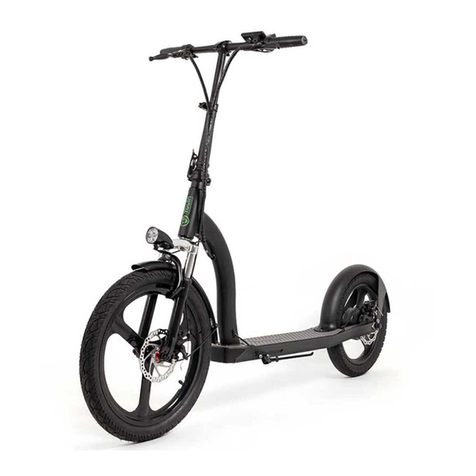
Youin
Youin YOU-GO 2XL Quick installation guide

KEEWAY
KEEWAY QJ50T-21U Maintenance manual




